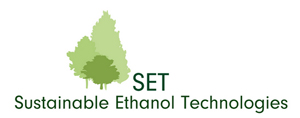Ethanol production must move away from the exclusive use of corn, or any food crops, as a feedstock. Our technology will allow for biomass diversification, and the use of the most abundant biomolecule on Earth: cellulose.
Producing Cellulosic Ethanol
Dr. Julie Goodliffe | Sustainable Ethanol Technologies
What is your background prior to Sustainable Ethanol Technologies?
Before starting SET, I was a professor of biology at UNC Charlotte, doing research and teaching in the fields of molecular genetics and developmental biology. I still consider myself a scientist, which I became while earning a PhD in molecular biology from Johns Hopkins, followed by 5 years of a postdoctoral fellowship in molecular genetics at Princeton University. After many years enjoying my time as a student and postdoctoral researcher, I realized that the job of professor didn't include enough actual science for me. I was teaching and doing administrative work much more than I was doing research or managing my lab. I realized that it was only getting worse, and anticipated 30 more years of a frustrating job. I decided to learn something about business so I could explore other jobs and new challenges, and earned an MBA in 2013 from UNC's Kenan-Flagler Business School via the MBA@UNC program.
Tell us a bit about Sustainable Ethanol Technologies and its role in the future of biofuel development?
 SET enables profitability in cellulosic ethanol. We solve the problem of expensive cellulosic ethanol production by using a biological approach, one that requires no hazardous chemicals, enzymes, high heat, biomass clean-up, or much water. Our patent-pending process uses living fungi to break down the lignin and cellulose in any lignocellulosic biomass, releasing sugars at extremely low cost. Our process can be used upstream of ethanol production by any existing ethanol producer for very low capital equipment costs, and no increase in operational expenses.
SET enables profitability in cellulosic ethanol. We solve the problem of expensive cellulosic ethanol production by using a biological approach, one that requires no hazardous chemicals, enzymes, high heat, biomass clean-up, or much water. Our patent-pending process uses living fungi to break down the lignin and cellulose in any lignocellulosic biomass, releasing sugars at extremely low cost. Our process can be used upstream of ethanol production by any existing ethanol producer for very low capital equipment costs, and no increase in operational expenses.
Ethanol production must move away from the exclusive use of corn, or any food crops, as a feedstock. Our technology will allow for biomass diversification, and the use of the most abundant biomolecule on Earth: cellulose. Sustainability in biofuels requires an abundant, non-food feedstock, and cellulose remains the best option.
How did you transition from being a scientist to an entrepreneur? In what ways did your MBA help with that transition?
I continued my job as professor in my first year of MBA coursework, and began to see the biology around me in terms of commercialization potential. My colleague at UNC Charlotte, Dr. Matthew Parrow (Associate Professor of Biology), was working on a patent for commercialization of cellulosic ethanol production. He was aware that his technology was the lowest-cost approach to cellulosic ethanol, and we spent a lot of time discussing it. The science behind the technology was solid, and the economics were unique for cellulosic ethanol production; this was the technology that could change the biofuels industry, and possibly even the entire liquid fuels market, to something truly sustainable.
As part of my required MBA coursework, I attended an immersion with my MBA classmates in San Francisco in 2012. The immersion focused on entrepreneurship and innovation, and Joe Kennedy, then the CEO of Pandora Radio, came to talk to us about his experience as an innovator and entrepreneur. He asked "what do you see that the rest of the world is blind to?" I knew that the dozens of biologists and engineers working on cellulosic ethanol were blind to my colleague's type of work, elegant, low-tech, and purely biological, because their solutions are very advanced but also very expensive. When I returned from San Francisco, I asked Dr. Parrow if he wanted to start a company to commercialize his technology, and we started SET, together with his graduate student and co-inventor Richard Giles. I suppose I became an entrepreneur then, and my MBA work helped me see the potential of Dr. Parrow's elegant biological solution to the problem of cellulosic ethanol commercialization.
What will your primary goal and duties be with the company?
My primary goal is to get the technology from academic science to industrial reality. That requires different approaches than those used in academic labs - publishable bench science cannot be scaled to millions of gallons of ethanol production. We need to optimize the technology using industrial approaches, minimizing costs while maximizing yield. We also need partners and customers who are ethanol producers, because they are the experts in a mature industry and our process is upstream of that process. My duties have been to direct us toward our goals with our pilot plant, and also bench science that is industry-friendly rather than high-cost experimental biology. I've also formed relationships that have helped us obtain the exclusive rights to the technology, obtain customers in the near future, obtain traction in the energy industry, and potentially obtain investors for us to build our own small-scale plant.
What makes the process you use different than what's currently being done?
Our process uses living fungi that grow through the biomass in solid state, breaking down the lignin and cellulose to release the sugars without any harsh chemical, biochemical, thermal or mechanical process. We can release the sugars of the biomass at extremely low cost, unlike any other cellulosic ethanol production process. Our process simply requires biomass handling and storage, two existing requirements for all ethanol producers, upstream of fermentation and distillation.
What is your timetable for the development and commercialization of the process?
We have some bench scale and pilot plant scale experiments to conduct this summer to complete the development. Our goal is to obtain our first ethanol-producer customer by the end of this year. This customer will negotiate with us for the rights to use our technology as a bolt-on process for their existing corn ethanol plant, enabling the use of crop residues or other cellulosic biomass for cellulosic ethanol production along with corn ethanol production. This first customer will be an important partner in further development of the process, helping us understand the details involved with scaling the technology. We will help that ethanol plant diversify its feedstock, with the hope of eventually allowing our customers to replace corn ethanol with cellulosic ethanol production.
Can you speak a bit about the recent studies that state that biofuels produce more greenhouse gas emissions than fossil fuels?
Yes - the Nature Climate Change article by Liska and others, published online April 20th of this year, modeled ten years of corn crop residue removal across the entire Corn Belt for cellulosic ethanol production. The mathmatical model suggested that the loss of soil organic carbon via residue removal, and the oxidation of that carbon into carbon dioxide, would cause cellulosic ethanol to have greenhouse gas emissions similar to those of gasoline. It's an alarming result, but one that is important because we can use the information to be sure that we don't do what the model assumed would be done for cellulosic ethanol production. For example, the model assumes that "crop residue is removed and no mitigation action is taken" to prevent soil erosion and loss of organic carbon.
We know how important that mitigation action is, and farmers have known it for a long time, but now we can make mitigation a priority. Also, the model ignores that the by-product of cellulosic ethanol production, lignin, can be burned to produce electricity to run the plant, reducing fossil fuel burning for generation of electricity. Now we know how important it is to use the lignin for electriciy generation and overall reduction in greenhouse gas emissions. Also, the model ignores that the removal of crop residue reduces amounts of the powerful greenhouse gas nitrous oxide - cellulosic ethanol may increase carbon dioxide but also decrease nitrous oxide at the same time. Therefore, overall greenhouse gas emissions for cellulosic ethanol that include carbon dioxide and nitrous oxide would be less than those for gasoline.
Considering overall greenhouse gas emissions, along with electricity generation using lignin, and mitigation of the loss of soil organic carbon, cellulosic ethanol will have greatly reduced greenhouse gas emissions compared to gasoline. Further, cellulose is the most abundant biomolecule on Earth, and it can be grown intelligently to provide liquid fuel for the world, therefore it will always be preferable to the limited supply of fossil fuels available to us as the world adds millions of new drivers each year.

Dr. Julie Goodliffe is CEO and co-founder of Sustainable Ethanol Technologies, LLC
Dr. Goodliffe majored in biology at Carnegie Mellon University, obtained a PhD in molecular biology at Johns Hopkins University, and pursued a scientific research career in molecular genetics. This path led her to a postdoctoral fellowship at Princeton University, in the Department of Molecular Biology, after which she joined the Department of Biology at UNC Charlotte as Assistant Professor. There she led a team of researchers in her own program of externally-funded molecular genetics research, and taught undergraduate and graduate level genetics courses. In 2013, Dr. Goodliffe earned an MBA from UNC's Kenan-Flagler Business School.
The content & opinions in this article are the author’s and do not necessarily represent the views of AltEnergyMag
Comments (0)
This post does not have any comments. Be the first to leave a comment below.
Featured Product

